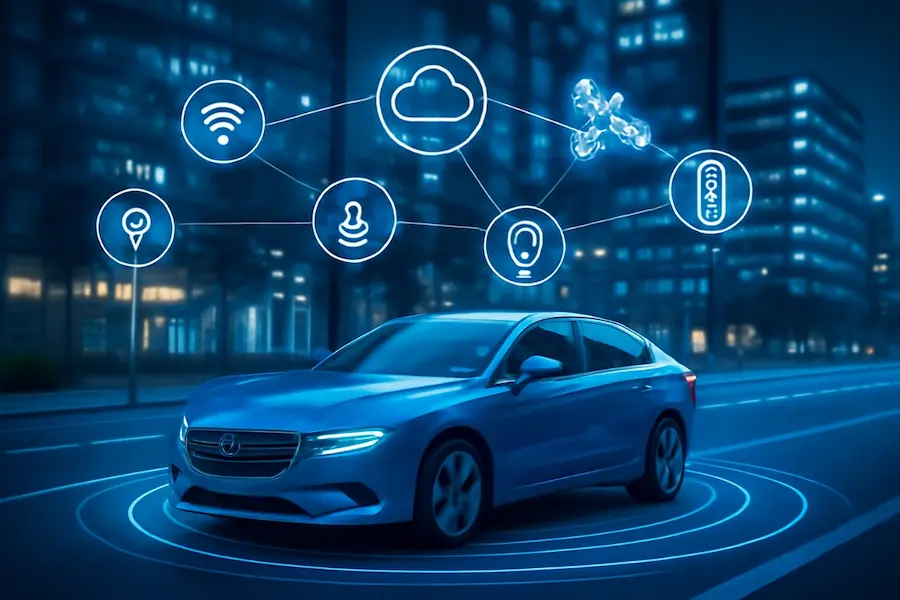The future of driving is here, and I got a glimpse of it not long ago. I had a drive that really opened my eyes a car that actually “talked” to the city and other vehicles around it. It helped me dodge a tough traffic jam, suggested a quicker route, and even found a parking spot nearby without me wasting time driving in circles. That moment made me see driving differently. It wasn’t just about the machine anymore; it was about the support it gave me.
Driving today is changing fast. It’s not just about cars alone it’s how technology and cities come together to make getting around smoother, safer, and way less stressful. Honestly, I think these changes will touch all of us before we know it.
The Role of Connected Vehicles in the Future of Driving
If you imagine connected cars as just fancy cars with big screens, you’re missing the point. They actually connect to the internet and chat with other cars, traffic lights, and even your phone. Using tools like GPS and sensors, they keep track of traffic, weather, and road conditions in real time.
I’ve felt the difference myself. One rainy night, my car gave me a heads-up about slippery patches before I even spotted them. It made me feel safer. If you haven’t experienced this tech yet, you might be surprised at how much it can ease your trips.
The Technologies Powering Connected Cars and Smart Cities
There’s a lot behind the scenes. The rollout of fast mobile networks like 5G is helping cars share info quickly though not everywhere has 5G yet, and many cars still use older networks.
Then there’s the “Internet of Things,” which connects all sorts of devices across the city from streetlights to parking meters so they can work together. Cars can talk to each other and to traffic signals. Smart programs analyze all this data to keep traffic moving and drivers safe.
It’s pretty amazing to see how these technologies are already becoming part of our daily lives.
The Role of Data and Analytics
Connected cars and smart cities generate mountains of data. What’s really cool is how this info is used. Cities can predict traffic snarls before they happen and guide cars to avoid them.
I’ve noticed apps that sync with my car telling me the best times to head out to skip the rush hour. It’s like having a smart travel buddy helping me avoid headaches. These insights don’t just make life easier they’re shaping how our cities grow.
The Role of Smart Cities in Mobility
Smart cities connect all the pieces roads, buses, and traffic lights to respond instantly to what’s happening on the streets. For example, traffic lights adjust their timing when roads get busy, so you don’t have to wait as long.
I remember once sitting at a light that felt perfectly timed to keep the cars moving. Later, I found out the city was using smart signals. It was a small thing, but it made my day run smoother.
Integration With Public Transportation and Multiple Travel Options
What really excites me is how connected cars work with buses, trains, bikes, and more. They don’t replace other ways to get around; they make it easy to mix and match.
Picture this: You park your bike, jump into a shared driverless car, and then catch a bus all planned through one simple app. This means fewer people need their own cars, which eases traffic and pollution.
How Connected Cars and Smart Cities Shape the Future of Driving
In the future of driving, the real magic happens when cars and city systems communicate seamlessly. Roads equipped with sensors send data to vehicles, and cars share real-time road conditions back to the network.
I remember a drive when my car warned me about a sudden stop ahead helping me avoid a crash. At the same moment, city traffic lights adjusted to ease the jam. It felt like an entire system working together to keep us safe and moving.
Impact on City Planning and Roads
These changes are reshaping cities. Smart parking systems help drivers find open spots quickly, saving a lot of time and frustration.
Some cities are planning special lanes for self-driving cars and roads that could one day charge electric cars as they drive. These ideas are still in early stages, but it’s exciting to see where things are heading.
Improving Safety on the Road
Safety means a lot to me. Connected cars give early warnings about dangers, while smart city sensors help protect pedestrians by stopping cars when needed.
Knowing that emergency responders get faster alerts after accidents helps me feel more at ease. These tools do more than just help they save lives.
Environmental Benefits and Cleaner Air
The future of driving is also greener. Connected cars, especially electric and hybrid models, help reduce air pollution. Smart traffic systems cut down on congestion, saving fuel and lowering emissions.
I’ve seen apps suggest routes that avoid traffic and improve fuel efficiency. These small innovations, when combined, lead to cleaner air and healthier cities..
The Convenience of Self-Driving Features
Fully self-driving cars are still being tested in some places, but many cars today have helpful features like cruise control that keeps your speed steady and parking assistance. These make driving easier and less tiring.
I use cruise control on long trips and really appreciate how it takes some of the pressure off. If you haven’t tried these features yet, I recommend giving them a go.
Economic and Social Effects
The future of driving brings more than just smarter vehicles it also reshapes how people work and move. While some driving-related jobs may be affected, new opportunities will emerge in tech and urban planning. Travel could become much easier for older adults and people with disabilities.
There are bigger questions too, like how cities will evolve and where public transit fits in. It’s a complex shift, but one filled with promise.
Laws and Rules for Connected Vehicles
Governments are working on rules to keep connected and self-driving cars safe, though progress isn’t the same everywhere. Clear laws about safety, who’s responsible in accidents, and data privacy are needed to build trust.
Privacy and Ethical Concerns
Privacy matters a lot. Connected cars collect tons of data, usually held by car makers or service companies. Knowing how this data is handled and protected is important.
There are concerns about location tracking and data misuse. Being open and fair about this will help people feel safe using these new technologies.
Challenges and Concerns Ahead
It’s not all smooth sailing. Cybersecurity risks and the need to upgrade infrastructure take time and money. Not everyone will get these benefits right away.
Still, I believe these challenges can be handled, and the advantages make it worth trying.
What This Means for Drivers Like Us
For drivers, these advances mean less stress and more safety. Real-time updates keep traffic moving, smart parking saves time, and driver assists make trips easier.
I’m looking forward to relaxing more on drives, knowing my car and city are working together to keep me safe.
Read Also:How Auto Tech is Changing Cars in 2025: Smarter, Safer, and Greener Driving
Real Examples Today
Cities like Singapore and London show how smart traffic and connected cars can work in real life. Seeing these examples makes me hopeful these benefits will spread worldwide.
Conclusion: Moving Toward a Connected Future
From my experience, the future of driving looks promising. Connected cars and smart cities are changing not only how we move but how we live.
Though challenges remain, with smart technology, clear rules, and care, this future will make travel safer, cleaner, and more enjoyable. It’s an exciting time to be on the road, and I’m glad to share this glimpse of what’s coming.

